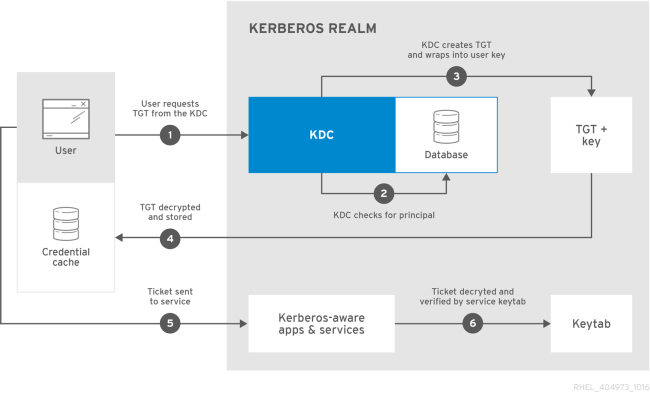Table of Contents
Kerberos unter Redhat / CentOS
Kerberos itself is a network protocol that enables authentication for users of client/server applications through the use of secret-key cryptography.

Kerberos is usually used for authenticating desktop users on networks, but through the use of some additional tools, it can be used to authenticate users to web applications and to provide SSO for a set of web applications. This essentially allows users who have already authenticated on their desktop network to seamlessly access secured resources in web applications without having to re-authenticate. This concept is known as Desktop-Based SSO since the user is being authenticated via a desktop-based authentication mechanism, and their authentication token or ticket is being used by the web application as well. This differs from other SSO mechanisms such as Browser-Based SSO, which authenticates users and issues tokens all via the browser.
The Kerberos protocol defines several components that it uses in authentication and authorization:
See → KERBEROS COMPONENTS
Einrichten von OpenLDAP
Install the basic LDAP server installation, type the following at a shell prompt:# yum install openldap openldap-clients openldap-servers

Einrichten von Kerberos
ACHTUNG! Bevor noch überhaupt irgendwie, mit dem Einrichten des Kerberos begonnen werden kann, müssen zuerst folgende Voraussetzungen zwingend erfüllt werden:
DNS Auflösung - Muss für alle Server/Clients funktionieren! (A und PTR Recorts/Auflösung)Die NTP Zeitsynchronisierung - Muss in jedem Fall, auf dem zukünftigen KDC eingerichtet sein!
Konfiguration Master KDC-Server
Install the required packages for the KDC:# yum install krb5-server krb5-libs krb5-workstation
- Edit the
/etc/krb5.confand/var/kerberos/krb5kdc/kdc.confconfiguration filesto reflect the realm name and domain-to-realm mappings.For example:[logging] default = FILE:/var/log/krb5libs.log kdc = FILE:/var/log/krb5kdc.log admin_server = FILE:/var/log/kadmind.log [libdefaults] default_realm = EXAMPLE.COM dns_lookup_realm = false dns_lookup_kdc = false ticket_lifetime = 24h renew_lifetime = 7d forwardable = true allow_weak_crypto = true [realms] EXAMPLE.COM = { kdc = kdc.example.com.:88 admin_server = kdc.example.com default_domain = example.com } [domain_realm] .example.com = EXAMPLE.COM example.com = EXAMPLE.COMA simple realm can be constructed by replacing instances of EXAMPLE.COM and example.com with the correct domain name— being certain to keep uppercase and lowercase names in the correct format — and by changing the KDC from kerberos.example.com to the name of the Kerberos server. By convention, all realm names are uppercase and all DNS host names and domain names are lowercase. Create the database using the kdb5_util utility:# kdb5_util create -s
The create command creates the database that stores keys for the Kerberos realm.The -s argument creates a stash file in which the master server key is stored.If no stash file is present from which to read the key, the Kerberos server (krb5kdc) prompts the user for the master server password (which can be used to regenerate the key) every time it starts.- Edit the
/var/kerberos/krb5kdc/kadm5.aclfile. This file is used bykadmindto determine which principals have administrative access to the Kerberos database and their level of access. For example:*/admin@EXAMPLE.COM *
Most users are represented in the database by a single principal (with a NULL, or empty, instance, such as joe@EXAMPLE.COM). In this configuration, users with a second principal with an instance of admin
(for example, joe/admin@EXAMPLE.COM)are able to exert full administrative control over the realm's Kerberos database. Afterkadmindhas been started on the server, any user can access its services by runningkadminon any of the clients or servers in the realm. However, only users listed in thekadm5.aclfile can modify the database in any way, except for changing their own passwords. - Create the first principal using
kadmin.localat the KDC terminal: ……
Konfiguration Kerberos Client
